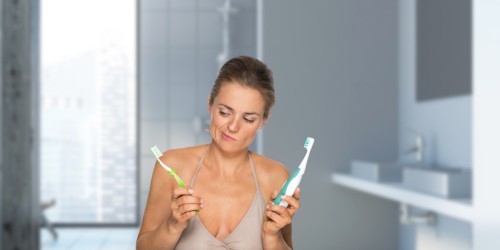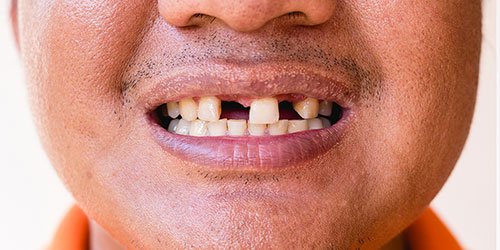Fibromas from lip biting
This topic reminds us of an old joke. A guy goes to the doctor and says, “It hurts when I bite my lip. What can I do?” The doctor then answers, “Don’t bite your lip.”
If only life were that simple. If you are in the 1% to 2% of the population suffering from fibromas (also known as reactive hyperplasia) due to lower lip biting, you know that the habit is tough to break.
Fortunately, MD Periodontics has extensive experience helping patients regain their flawless lips, cheeks, and gums marred from local irritation.

What is oral fibroma?
An oral fibroma – also referred to as an irritation fibroma – is a common reaction to ongoing inflammation in the mouth. In addition to the lips, fibromas may appear on the inside of the cheek, labial mucosa (salivary gland), tongue, and maxillary gingiva (upper gums).
Though most prominent among older men and women, a fibroma of the oral cavity can occur at any age.
Rarely cancerous, the unsightly round or oval fibroma has a smooth surface and looks like a cyst. The color can be pink or white depending on where it is located and the diameter generally ranges from 1 to 2 millimeters.
Because a fibroma is composed of connective tissue, the smooth, raised nodule is usually firm to the touch; unlike the softer, fat-filled lipoma.
Oral fibromas develop over weeks and sometimes reach 1 centimeter or more in diameter.
Is oral fibroma dangerous?
On its own, no. However, symptoms of traumatic fibromas can overlap with other conditions or injuries. For example, when there are many lesions, diseases such as Cowden syndrome and giant cell fibroma need to be considered. Because there are many possible differential diagnoses, other tests may be recommended or your oral surgeon may perform a biopsy on the fibroma.
The only treatment for an oral fibroma is to have a medical professional remove it.
What causes a fibroma in your mouth?
As the name implies, traumatic fibromas are caused by trauma or chronic irritation to the lips, cheeks, or tongue. Common causes include:
- Compulsive behavior such as biting your cheeks or lips
- Any type of trauma, injury, or irritation in the mouth
- Ill-fitting dentures that rub on the cheek or tongue over time
- Improperly placed dental restorations that irritate surrounding soft tissues
- Rubbing the smooth cheek or tongue on a rough tooth
What are oral fibroma symptoms?
While you are busy compulsively biting your lip a fibroma may be developing. There are, however, several symptoms that can tip you off that trouble lies ahead.
Take notice if any of these types of fibrous tissue appear:
- Unusual lumps in the mouth
- Coarse surfaces on the cheeks and gums
- White or dark patches inside the cheeks or on the gums
At this point, you may be able to head off the developing fibroma. If the budding fibroma is caused by a habit such as cheek or lip biting, try breaking the habit. It may be challenging but worth the effort.
If you wear ill-fitting dentures, follow up with your dentist or periodontist to adjust them.
Oral fibroma treatment
The only treatment for an oral fibroma is to have a medical professional remove it. There are two ways to alleviate oral fibromas:

Soft tissue laser removal
Laser removal offers a quick and painless way to remove the growth. After applying local anesthesia to the area, the dentist uses a powerful laser to sweep over the fibroma until it is gone. The procedure is relatively pain-free, with no bleeding, and takes only about 15 minutes.
Surgical excision
This technique accomplishes the same result as a laser, except the fibroma is cut out by the dentist. After numbing the surrounding area, the dentist uses a razor-sharp scalpel to remove the fibroma. After the fibroma is removed, the dentist cleans the area and places several sutures to close the wound.
Because fibromas may indicate a chance of oral cancer, the dentist may biopsy the fibroma for histological confirmation. The principal difference between laser removal and surgical removal is caring for the wound afterward.
Surgical excision is a surgery and will leave a sutured wound. It’s important to look for any signs of infection such as fever, pain, swelling, and discharge.
Can I do oral fibroma removal at home?
Some bloggers have claimed success using a saltwater rinse or turmeric paste to treat traumatic fibromas. But the only proven treatment is professional removal of the hardened tissue.
Why trust MD Piero to remove your oral fibroma
Noted board-certified periodontists Dr. Abdy Moshrefi D.D.S and Dr. Nazy Daneshmand D.D.S. utilize modern technology, professional staff, and well-honed skills to promote oral medicine and correct oral pathology.
At our beautiful Beverly Hills offices, MD Periodontics offers patients the best periodontal treatment that Los Angeles has to offer. Our holistic approach to dentistry ensures that your treatment utilizes the least toxic materials available, the most advanced technology, and amenities including aromatherapy to minimize discomfort and stress during procedures. You’ll experience a supportive atmosphere you would never expect to find at a dental office and results that you will love.
To schedule a consultation, click here or call us at (310) 859-9449. Your smile will thank you!
We are conveniently located throughout Southern California and the Los Angeles area. Our Beverly Hills office is conveniently located near West Los Angeles, Culver City, West Hollywood, Downtown Los Angeles, Marina del Rey, Pacific Palisades, Malibu, Manhattan Beach, Sherman Oaks, and Encino.
References
F. Kendrick and W. F. Waggoner, “Managing a peripheral ossifying fibroma,” Journal of Dentistry for Children, vol. 63, no. 2, pp. 135–138, 1996.
L. K. Mathur, A. P. Bhalodi, B. Manohar, A. Bhatia, N. Rai, and A. Mathur, “Focal fibrous hyperplasia: a case report,” International Journal of Dental Clinics, vol. 2, no. 4, 2010.
- How To Pick The Best Dental Implant Specialist Near Me - September 17, 2024
- Can Bleeding Gums Be a Symptom of Something More Serious? - May 27, 2024
- What Is Hydroxyapatite Toothpaste, and Is It Better for You? - May 1, 2024
 (310) 859-9449
(310) 859-9449 Is Lip Biting Actually Bad? What Causes Oral Fibromas?
Is Lip Biting Actually Bad? What Causes Oral Fibromas?















































